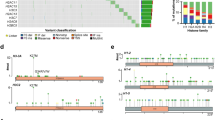Abstract
Mutations in epigenetic pathways are common oncogenic drivers. Histones, the fundamental substrates for chromatin-modifying and remodelling enzymes, are mutated in tumours including gliomas, sarcomas, head and neck cancers, and carcinosarcomas. Classical ‘oncohistone’ mutations occur in the N-terminal tail of histone H3 and affect the function of polycomb repressor complexes 1 and 2 (PRC1 and PRC2). However, the prevalence and function of histone mutations in other tumour contexts is unknown. Here we show that somatic histone mutations occur in approximately 4% (at a conservative estimate) of diverse tumour types and in crucial regions of histone proteins. Mutations occur in all four core histones, in both the N-terminal tails and globular histone fold domains, and at or near residues that contain important post-translational modifications. Many globular domain mutations are homologous to yeast mutants that abrogate the need for SWI/SNF function, occur in the key regulatory ‘acidic patch’ of histones H2A and H2B, or are predicted to disrupt the H2B–H4 interface. The histone mutation dataset and the hypotheses presented here on the effect of the mutations on important chromatin functions should serve as a resource and starting point for the chromatin and cancer biology fields in exploring an expanding role of histone mutations in cancer.
This is a preview of subscription content, access via your institution
Access options
Access Nature and 54 other Nature Portfolio journals
Get Nature+, our best-value online-access subscription
$29.99 / 30 days
cancel any time
Subscribe to this journal
Receive 51 print issues and online access
$199.00 per year
only $3.90 per issue
Buy this article
- Purchase on Springer Link
- Instant access to full article PDF
Prices may be subject to local taxes which are calculated during checkout




Similar content being viewed by others
Data availability
All data analysed are included in this Analysis and its Supplementary Information. These data are also available in an interactive format (https://bit.ly/2GXH5Ve) except private institutional data that are currently embargoed, but are slated for release to AACR Genie according to established protocols. Also see the cBioPortal main page (https://www.cbioportal.org) ‘Example Queries’ section to link to a real-time query of histone mutations.
References
Luger, K., Mäder, A. W., Richmond, R. K., Sargent, D. F. & Richmond, T. J. Crystal structure of the nucleosome core particle at 2.8 Å resolution. Nature 389, 251–260 (1997).
Allis, C. D., Jenuwein, T. & Reinberg, D. Epigenetics (Cold Spring Harbour Laboratory Press, New York, 2007).
Strahl, B. D. & Allis, C. D. The language of covalent histone modifications. Nature 403, 41–45 (2000).
Jenuwein, T. & Allis, C. D. Translating the histone code. Science 293, 1074–1080 (2001).
Shen, H. & Laird, P. W. Interplay between the cancer genome and epigenome. Cell 153, 38–55 (2013).
Schwartzentruber, J. et al. Driver mutations in histone H3.3 and chromatin remodelling genes in paediatric glioblastoma. Nature 482, 226–231 (2012).
Behjati, S. et al. Distinct H3F3A and H3F3B driver mutations define chondroblastoma and giant cell tumor of bone. Nat. Genet. 45, 1479–1482 (2013).
Wu, G. et al. Somatic histone H3 alterations in pediatric diffuse intrinsic pontine gliomas and non-brainstem glioblastomas. Nat. Genet. 44, 251–253 (2012).
Lohr, J. G. et al. Discovery and prioritization of somatic mutations in diffuse large B-cell lymphoma (DLBCL) by whole-exome sequencing. Proc. Natl Acad. Sci. USA 109, 3879–3884 (2012).
Papillon-Cavanagh, S. et al. Impaired H3K36 methylation defines a subset of head and neck squamous cell carcinomas. Nat. Genet. 49, 180–185 (2017).
Zhao, S. et al. Mutational landscape of uterine and ovarian carcinosarcomas implicates histone genes in epithelial-mesenchymal transition. Proc. Natl Acad. Sci. USA 113, 12238–12243 (2016).
Lewis, P. W. et al. Inhibition of PRC2 activity by a gain-of-function H3 mutation found in pediatric glioblastoma. Science 340, 857–861 (2013).
Chan, K. M. et al. The histone H3.3K27M mutation in pediatric glioma reprograms H3K27 methylation and gene expression. Genes Dev. 27, 985–990 (2013).
Lu, C. et al. Histone H3K36 mutations promote sarcomagenesis through altered histone methylation landscape. Science 352, 844–849 (2016).
Fang, D. et al. The histone H3.3K36M mutation reprograms the epigenome of chondroblastomas. Science 352, 1344–1348 (2016).
Kandoth, C. et al. Mutational landscape and significance across 12 major cancer types. Nature 502, 333–339 (2013).
Kruger, W. et al. Amino acid substitutions in the structured domains of histones H3 and H4 partially relieve the requirement of the yeast SWI/SNF complex for transcription. Genes Dev. 9, 2770–2779 (1995).
Gao, J. et al. 3D clusters of somatic mutations in cancer reveal numerous rare mutations as functional targets. Genome Med. 9, 4 (2017).
Horn, P. J., Crowley, K. A., Carruthers, L. M., Hansen, J. C. & Peterson, C. L. The SIN domain of the histone octamer is essential for intramolecular folding of nucleosomal arrays. Nat. Struct. Biol. 9, 167–171 (2002).
Lu, P. & Roberts, C. W. M. The SWI/SNF tumor suppressor complex: regulation of promoter nucleosomes and beyond. Nucleus 4, 374–378 (2013).
Hodges, C., Kirkland, J. G. & Crabtree, G. R. The many roles of BAF (mSWI/SNF) and PBAF complexes in cancer. Cold Spring Harb. Perspect. Med. 6, a026930 (2016).
McGinty, R. K. & Tan, S. Recognition of the nucleosome by chromatin factors and enzymes. Curr. Opin. Struct. Biol. 37, 54–61 (2016).
Dann, G. P. et al. ISWI chromatin remodellers sense nucleosome modifications to determine substrate preference. Nature 548, 607–611 (2017).
Arimura, Y. et al. Cancer-associated mutations of histones H2B, H3.1 and H2A.Z.1 affect the structure and stability of the nucleosome. Nucleic Acids Res. 46, 10007–10018 (2018).
Das, C. & Tyler, J. K. Histone exchange and histone modifications during transcription and aging. Biochim. Biophys. Acta. 1819, 332–342 (2013).
Ye, J. et al. Histone H4 lysine 91 acetylation a core domain modification associated with chromatin assembly. Mol. Cell 18, 123–130 (2005).
Yan, Q. et al. BBAP monoubiquitylates histone H4 at lysine 91 and selectively modulates the DNA damage response. Mol. Cell 36, 110–120 (2009).
Tessadori, F. et al. Germline mutations affecting the histone H4 core cause a developmental syndrome by altering DNA damage response and cell cycle control. Nat. Genet. 49, 1642–1646 (2017).
Vogelstein, B. et al. Cancer genome landscapes. Science 339, 1546–1558 (2013).
Allis, C. D. & Muir, T. W. Spreading chromatin into chemical biology. ChemBioChem 12, 264–279 (2011).
Atlasi, Y. & Stunnenberg, H. G. The interplay of epigenetic marks during stem cell differentiation and development. Nat. Rev. Genet. 18, 643–658 (2017).
Cerami, E. et al. The cBio cancer genomics portal: an open platform for exploring multidimensional cancer genomics data. Cancer Discov. 2, 401–404 (2012).
Gao, J. et al. Integrative analysis of complex cancer genomics and clinical profiles using the cBioPortal complementary data sources and analysis options. Sci. Signal. 6, 1–20 (2014).
Zehir, A. et al. Mutational landscape of metastatic cancer revealed from prospective clinical sequencing of 10,000 patients. Nat. Med. 23, 703–713 (2017).
Cheng, D. T. et al. Memorial Sloan Kettering-integrated mutation profiling of actionable cancer targets (MSK-IMPACT): A hybridization capture-based next-generation sequencing clinical assay for solid tumor molecular oncology. J. Mol. Diagn. 17, 251–264 (2015).
Acknowledgements
We thank the patients who provided tissue for the sequencing that underlies this work. We also thank members the Allis and Muir laboratories and the P01 team. We acknowledge N. Socci of the MKSCC Bioinformatics Core (funded in part through the NIH/NCI Cancer Center Support Grant P30-CA008748). Funding support includes: P01CA196539 (C.D.A., T.W.M.), F32GM123659 (J.D.B.), U24-CA220457-01(J.G., R.K., N.S.), 2T32CA009512-29A1 (B.A.N.), the C. H. Li Memorial Scholar Fund (L.F.), Damon Runyon Cancer Research Foundation DRG-2185-14 (A.A.S.), the Marie-Josée and Henry R. Kravis Center for Molecular Oncology, National Cancer Institute Cancer Center Core Grant no. P30-CA008748, and STARR Cancer Consortium (I9-A9-062).
Reviewer information
Nature thanks Stefan Pfister and the other anonymous reviewer(s) for their contribution to the peer review of this work.
Author information
Authors and Affiliations
Contributions
B.A.N. and C.D.A. conceptualized and initiated the project. All authors assisted with data analysis, hypothesis generation, and writing the manuscript.
Corresponding authors
Ethics declarations
Competing interests
The authors declare no competing interests.
Additional information
Publisher’s note: Springer Nature remains neutral with regard to jurisdictional claims in published maps and institutional affiliations.
Extended data figures and tables
Extended Data Fig. 1 Sample characteristics.
One sample per patient in which TMB ≤ 10 mutations per Mb is shown, except in c, in which all samples are represented regardless of the TMB. a, Tumour allele frequency distribution for 1,452 out of 1,921 tumours in which allele frequency is available based on publicly available data. b, Detailed tumour allele frequency distribution for the four most frequency mutated residues. Blue bars represent the median. c, TMB distribution. d, Tumour type distribution. For display purposes, the main cancer types are used in place of detailed cancer type. e, f, Oncoprint of the distribution of histone mutations between core families on a per patient level for all TMB values (e) and for TMB ≤ 10 mutations per Mb (f). For display purposes, H2A variants and H3.5 are not shown.
Extended Data Fig. 2 Validation of TMB ≤ 10 as an analysis threshold.
a, For known oncohistones, the number of mutations captured reaches a plateau at a TMB of greater than 10 mutations per Mb. b, c, Histogram plot of H3 mutation distribution on a per patient level without a TMB threshold (b) and with a TMB ≤ 10 threshold (c) shows enrichment of known oncohistones as well as additional mutations compared to background.
Extended Data Fig. 3 Heat map of histone H3 mutations with individual residue labels.
Colour intensity indicates normalized mutation count (number of mutations at residue/number of samples per cancer type). Red labels indicate positions of known oncohistones. Per patient data with all TMB values plotted. The numbers of tumours sequenced are indicated following the tumour type label.
Extended Data Fig. 4 Heat map of histone H4 mutations with individual residue labels.
Colour intensity indicates normalized mutation count (number of mutations at residue/number of samples per cancer type). Per patient data with all TMB values plotted. The numbers of tumours sequenced are indicated following the tumour type label.
Extended Data Fig. 5 Heat map of histone H2A mutations with individual residue labels.
Colour intensity indicates normalized mutation count (number of mutations at residue/number of samples per cancer type). Per patient data with all TMB values plotted. The numbers of tumours sequenced are indicated following the tumour type label.
Extended Data Fig. 6 Heat map of histone H2B mutations with individual residue labels.
Colour intensity indicates normalized mutation count (number of mutations at residue/number of samples per cancer type). Per patient data with all TMB values plotted. The numbers of tumours sequenced are indicated following the tumour type label.
Extended Data Fig. 7 Histogram showing mutational frequency from the dataset in histones across all cancers.
One tumour per patient in which a TMB ≤ 10 mutations per Mb is shown. Boxes in the amino acid sequence show the globular domains of each histone. Amino acids with known post-translational modifications are marked in red, and the type of modification is shown by the bars below the histogram.
Extended Data Fig. 8 Proximity heat map showing distances between the most frequently mutated residues in the nucleosome structure.
Samples with TMB ≤ 10 mutations per Mb and mutation counts ≥2.5-fold the median number of mutations per residue for the histone family are displayed. Plotted residues are shown on the axes. Numbers within the grid indicate distance in angstroms between α-carbons. PDB code 1KX5.
Extended Data Fig. 9 Proximity heat map showing distances between the most frequently mutated residues (horizontal axis) and sites of known PTMs (vertical axis).
Per patient data at TMB ≤ 10 mutations per Mb is shown for samples with mutation counts ≥2.5-fold the median mutations per residue for the histone family.
Extended Data Fig. 10 Frequently mutated residues converge in three-dimensional space.
Examples of residues with α-carbons within 11.4 Å that are mutated ≥2.5-fold over the median counts per residue for each histone family, when a TMB ≤ 10 mutations per Mb threshold is applied. Residues of interest are mapped on the nucleosome structure (PDB code 1KX5).
Supplementary information
Supplementary Table 1
This file contains all histone mutations.
Supplementary Table 2
This file contains histone mutations on a per patient basis.
Supplementary Table 3
This file contains histone mutations on a per patient basis where TMB ≤ 10 mutations/Mb.
Supplementary Table 4
This file contains histone mutations on a per patient basis where TMB ≤ 2 mutations/Mb.
Supplementary Table 5
This file contains the list of histone genes used to query tumor mutation databases.
Rights and permissions
About this article
Cite this article
Nacev, B.A., Feng, L., Bagert, J.D. et al. The expanding landscape of ‘oncohistone’ mutations in human cancers. Nature 567, 473–478 (2019). https://doi.org/10.1038/s41586-019-1038-1
Received:
Accepted:
Published:
Issue Date:
DOI: https://doi.org/10.1038/s41586-019-1038-1
This article is cited by
-
Beyond genetics: driving cancer with the tumour microenvironment behind the wheel
Nature Reviews Cancer (2024)
-
Epigenomic insights into common human disease pathology
Cellular and Molecular Life Sciences (2024)
-
CD72, a new immune checkpoint molecule, is a novel prognostic biomarker for kidney renal clear cell carcinoma
European Journal of Medical Research (2023)
-
Pan-cancer atlas of somatic core and linker histone mutations
npj Genomic Medicine (2023)
-
Cancers make their own luck: theories of cancer origins
Nature Reviews Cancer (2023)
Comments
By submitting a comment you agree to abide by our Terms and Community Guidelines. If you find something abusive or that does not comply with our terms or guidelines please flag it as inappropriate.



